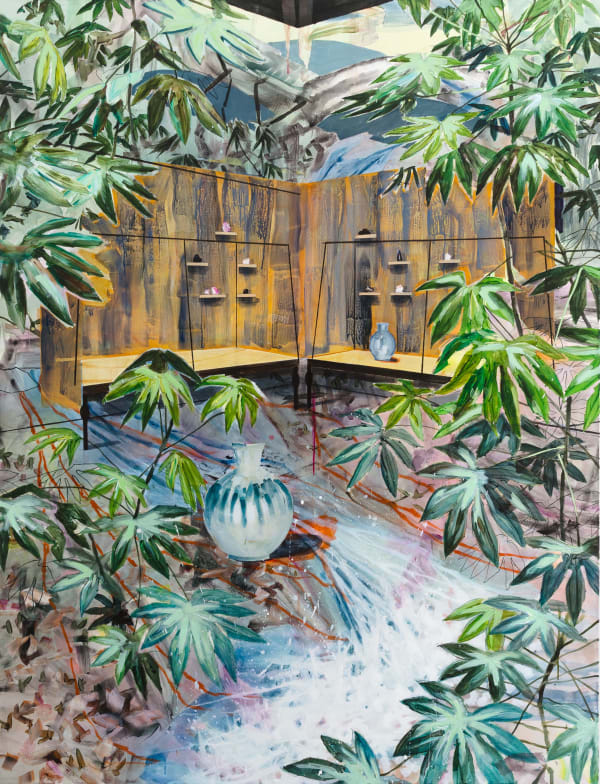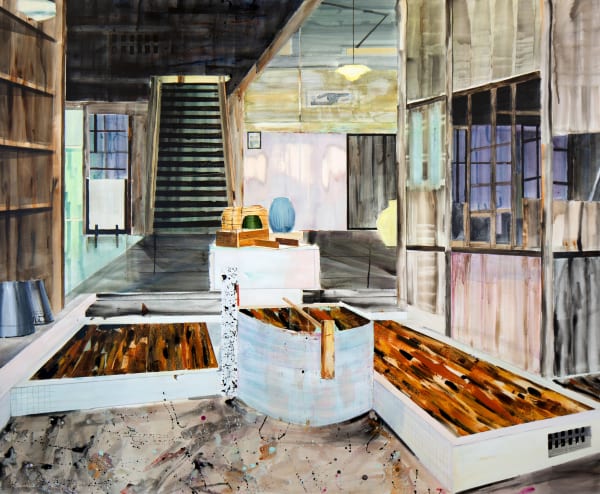Elizabeth Thun | Gränsland
Standing before Elizabeth Thun’s work is like standing before Birgitta Trotzig’s threshold, the one described in her 1996 book Sammanhang. The threshold that is neither here nor there. Birgitta Trotzig asks herself where, not how, the imaginary space unfolds, that which is neither one nor the other. And the question is in good keeping with Elizabeth Thun’s evocative imagery.
– Anna Norberg, "Wanderings", 2024
Elizabeth Thun’s vivid paintings draw inspiration from landscapes she has traversed, architectural structures, and memories that have made a lasting impression on her. As viewers, we are faced with reinterpreted realities where indoor and outdoor environments seem to overlap and fade into one another, often resulting in a sense of dissolving space. A forest scene may seamlessly transition into the interior of a room, where disparate objects, abstract elements and patterns are carefully woven into the composition.
Just as memories can influence our perception of a particular place, the use of double exposure in Thun’s work suggests a narrative depth where past and present, memory and reality, coexist within the same image. This approach allows her to explore themes of memory, identity, and the passage of time, all while maintaining a strong connection to the physical landscapes that inspire her work.
Nature serves as a recurring point of reference, representing both a retreat from modern city life and a symbol of transcendence and enigma. The exhibition Gränsland features both interior scenes and landscapes, majestic residential homes, museum buildings, waterfalls, and verdant forest paths. The motifs are inspired by Elizabeth Thun’s impressions from following in the footsteps of the 17th century Japanese poet Matsuo Bashō. Known for his depictions of nature and his extensive journeys by foot through coastal landscapes, countryside, and forests, he is today considered one of the greatest masters of haiku poetry. Like Bashō, Thun has embraced walking as part of her artistic practice, where it serves not only as a means of exploration and documentation, but as a process in which physical landscapes are fused with memory and history.
Elizabeth Thun (b. 1978) lives and works in Malmö and holds an MFA from Bergen Art Academy, Bergen. Previous solo exhibitions include Berg Gallery, Stockholm (2021), Ljungbergmuseet, Ljungby (2020), Galleri Ping-Pong, Malmö (2019), Galleri Arnstedt, Östra Karup (2018), and Nationaltheatret, Oslo (2013). In addition, Thun has participated in group exhibitions at Skissernas Museum, Lund, Ystads Konstmuseum, Moderna Museet, Malmö, Havremagasinet, Boden, Galleri Thomas Wallner, Simris, and Ayumi Gallery/Cave, Tokyo, to name a few. Thun's works are represented in the collections of Public Art Agency Sweden, Sveriges Riksdag, SAK (the Swedish Association for Art), Sørlandets Kunstmuseum, Kristiansand (NO) and Filosofiska Institutet, Bergen (NO), as well as in several regional collections.
-
 Elizabeth Thun, Stillness and Movement, 2024
Elizabeth Thun, Stillness and Movement, 2024 -
 Elizabeth Thun, The lamp kept burning all night, 2024
Elizabeth Thun, The lamp kept burning all night, 2024 -
 Elizabeth Thun, Study Room, 2024
Elizabeth Thun, Study Room, 2024 -
 Elizabeth Thun, The Collector I, 2024
Elizabeth Thun, The Collector I, 2024 -
 Elizabeth Thun, The Collector II, 2024
Elizabeth Thun, The Collector II, 2024 -
 Elizabeth Thun, Odaki Falls, 2024
Elizabeth Thun, Odaki Falls, 2024 -
 Elizabeth Thun, Grönt föremål i monter, 2023
Elizabeth Thun, Grönt föremål i monter, 2023 -
 Elizabeth Thun, Gränsland, 2024
Elizabeth Thun, Gränsland, 2024 -
 Elizabeth Thun, Ito Residence, 2023
Elizabeth Thun, Ito Residence, 2023 -
 Elizabeth Thun, Bord på ljust marmorgolv, 2023
Elizabeth Thun, Bord på ljust marmorgolv, 2023











